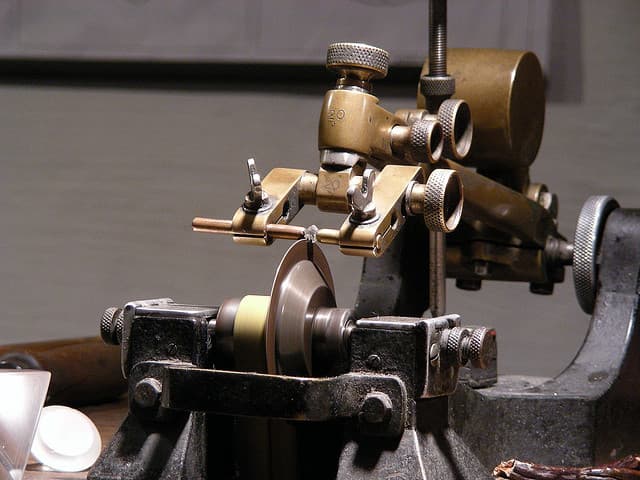Diamond Cutting for Hobbyists: Getting Started
With study, care, and the right tools, hobbyist gem cutters can add diamond cutting to their repertoire. Get started with these tips from expert cutters.
2 Minute Read
Answer: With study, care, and the right tools, diamond cutting is not out of reach for hobbyist gem cutters.
Diamond Cutting Books and Equipment
In my opinion, the best books for you to start with are Diamond Cutting by Basil Watermeyer and The Techniques of Master Faceting by Gerald Wykoff. The Watermeyer is exclusively about diamonds, of course. The Wykoff has a great chapter on faceting diamonds.
Diamond cutting is not impossible on standard faceting equipment, but it's a formidable task requiring a good deal of care and study. You can start with a typical hobby faceting machine designed to cut colored stones. However, it's easier with a diamond cutting scaife machine. These are larger in diameter (about 10 or 12 inches) and run faster (2600 rpm vs. about 1100 rpm) than faceting machines. You would cut on a cast iron lap made up as a dry wheel. Wykoff gives some instructions on preparing one of these. Essentially, it's diamond grit in Elmer's Glue or similar.
Aside from having the right machinery, the most important factor for proper diamond cutting is orienting the stone correctly to grind and polish with the grain. Diamond varies in hardness according to polishing direction and orientation. The easiest way to start learning would be recutting damaged diamonds, since the first cutter already determined the proper orientation. Otherwise, you have to study the stone to determine the crystal axes and orient the facets accordingly. A facet placed on the hardest plane will be nearly impossible to grind or polish. This is why professional diamond cutters sometimes "swindle" (cut slightly off the correct angle or elevation) some facets, depending on the orientation of the crystal.
Regards,
Roy Kersey
Diamond Rough and Crystallography
If you want to learn diamond cutting, I cannot emphasize enough the importance of studying and learning the crystallography of the diamond rough itself. Having been trained as a diamond cutter, I can tell you the majority of the training time was spent on the study of the crystal and its various forms and structure. Isometric in system and octahedron in shape (for ideal cutting), the diamond can at times offer a great many surprises. Directional hardness, as Roy mentioned, is just one.
Diamond rough is not as hard to get a hold of as you might expect. Most that is available now is coming from Africa, Brazil, and even the United States.
Ron Campbell, Central Coast Gem Lab
International Gem Society
Related Articles
Diamond Value, Price, and Jewelry Information
Best Diamond Color for Rose Gold Rings
Color Grading Fancy Colored Diamonds
Is a VS1 Clarity Diamond a Good Buy?
Never Stop Learning
When you join the IGS community, you get trusted diamond & gemstone information when you need it.
Get Gemology Insights
Get started with the International Gem Society’s free guide to gemstone identification. Join our weekly newsletter & get a free copy of the Gem ID Checklist!
